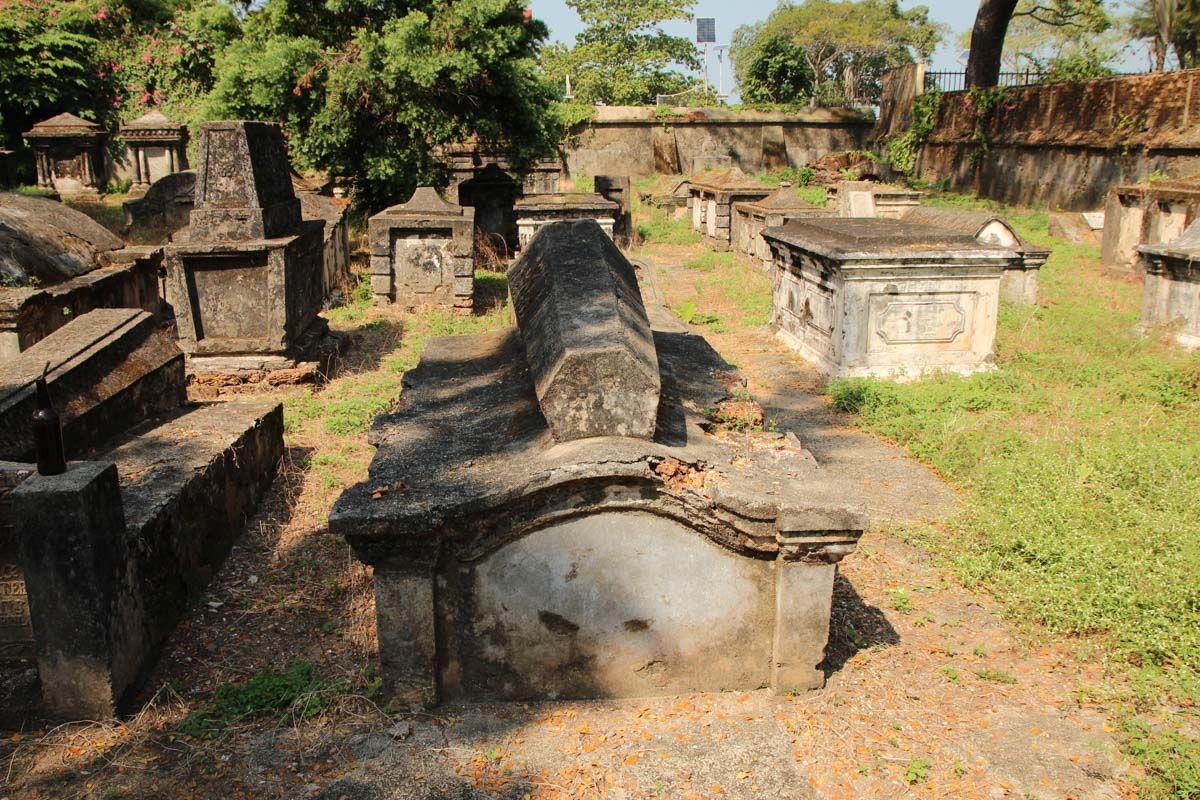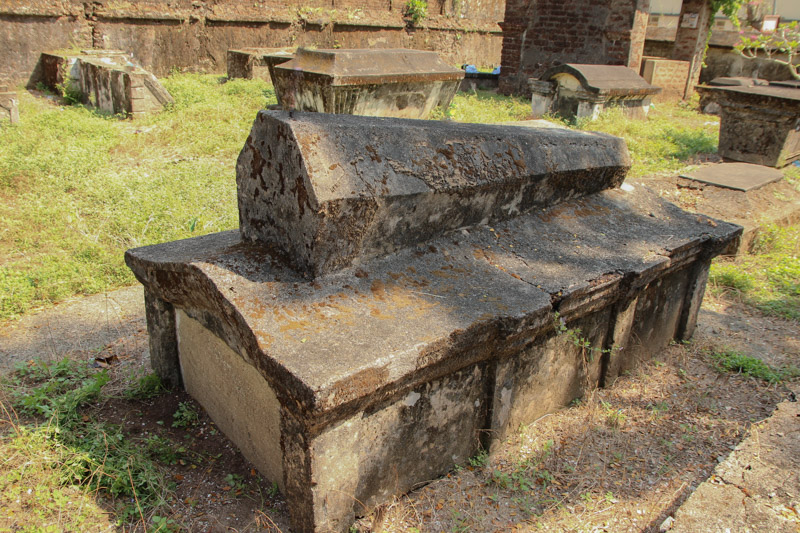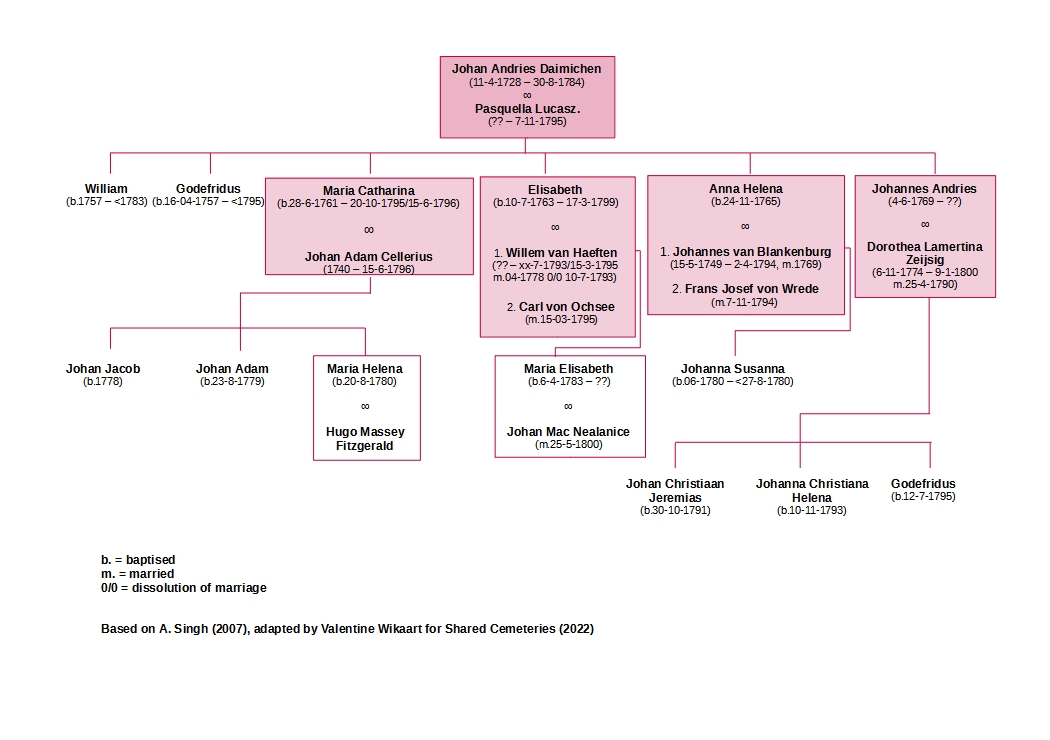
Fort Kochi - Johan Daimichen (1728-1784)
The German Johan Daimichen had already made a long journey before he arrived in Amsterdam from Lubeck and probably fell into the hands of crimps of the VOC. With a debt of 150 guilders to a certain M. Meijers, he was registered as Johan Andreas Deijmiche on 28 April 1751 by the bookkeeper of the VOC.
Daimichen had to settle for a position as a soldier with the meager income of 9.00 guilders a month on the ship the Eendracht. The ship had a fast crossing and docked already on 12 October in Batavia (modern day Jakarta, Indonesia). With an earnings of 49.50 guilders Johan Daimichen signed off with a balance debit of 122.75 guilders.[i] It was not until 1756 that the last bit of his debt was repaid. He had little time to get to know Batavia, because after 18 days he was sent on to Kochi on the Malabar coast. With the exception of a brief transfer to Cananoor between 1754 and 1756, he would spend the rest of his life in Kochi. On the Malabar coast it soon became apparent that he had more capabilities than that of a soldier. Daimichen was good at numbers and was soon hired as a bookkeeper. He also proved to be a fluent student in the Dutch language, so that he could do secretarial work as first clerk of the police and secretary of justice. He would act as a witness to hundreds of wills until his death. With his job improvement, his salary also increased to 360 guilders per year.
Meanwhile, Johan Daimichen had met a local woman, Pasquella Lucasz, and married her around 1756. Pasquella Lucasz was the daughter of Willem Lucasz Smit, accountant and resident of Cranganoor, and his first wife Maria Kellensz.[ii] The fact that Johan was a Lutheran and Pasquella Catholic did not stand in the way of a marriage. However, there was no Catholic cleric in Kochi, for that they had to go to Vaipin, to the north of Kochi. The church in Kochi, which was in use as a Dutch Reformed church during the VOC period, would, certainly during the pastorship of Pieter Cornelisz, offer shelter to Reformed, Lutherans, Mennonites and even Jews who were allowed to hold their worship services there.
Together Johan and Pasquella would have three sons, William, Godefridus and Johannes, and three daughters Maria, Elisabeth and Anna. Through his marriage, Daimichen joined a family that had an extensive network among the mestiços population[iii] and offered him numerous opportunities to become prosperous through the coastal trade. That he became prosperous is apparent from the survey made in 1776 of the families living in Kochi. Johan Daimichen then appears with his family. In addition to a native woman, he had 24 resident enslaves, being 12 men, 6 women, 4 boys and 2 girls.[iv]
In July 1783 Johan was already ill and the couple decided to have a will drawn up. The eldest son William already died by then. Godefridus, who worked as a clerk for the VOC in Batavia, and Johan Andries Jr. were each immediately paid 4.000 rupies because their sisters had already had it when they got married. Their first grandchild Jan Jacob Cellarius was also awarded 500 rupies. Johan's sisters, Margaritha and Katharina, living in Germany, received his wages that were in the books in the Netherlands with the VOC and their young enslaved Filander had to be set free.[v] Johan was only 56 years old when he died in 1784.
 Tomb of Johan Daimichen (photo Leon Bok, 2020)
Tomb of Johan Daimichen (photo Leon Bok, 2020)
The tomb Johan Daimichen is remarkable from a Dutch perspective, as it depicts a coffin on top, which is not very common. Daimichen still experienced that he became a grandfather, but no longer that he became the ancestor of a family that would have a prominent place in Kochi for a long time and that would grow into a very prosperous family. The family would also leave its mark on the Dutch cemetery. The text on the monument: Hier rust / Ter salige opstandigen het lyk / van weledelen Heer / Johann Daimichen / In leeven onderkoopman en sekretaris van Politsie ge- / booren te Lubeck de 11 April 1728 / obiit den 30 augustus 1784. In translation: Here rests / awaiting his resurrection the corpse/ of the well-born sir / Johan Daimichen / in his life junior merchant and secretary of police / born in Lubeck on 11 April 1728, died 30 August 1784.
Pasquella Lucasz died 7 November 1795 and her estate was publicly sold. It gives an insight into how she lived. In addition to the houses she owned, she also had a large collection of jewellery, for more than a month she could put on a clean jacket every day without having to wash one of them. She drank coffee and tea from gilded cups, ate with silver cutlery from Japanese porcelain plates and had a large number of enslaved people who were divided among the children after her death and a few were set free. Part of the inventory was sold for 3,943:19:¼ rupya. Apart from all the things she had described for her children or grandchildren, such as the house she had inherited from her parents and belonged to her son Johan and her clothes and jewellery to her daughters, for each of the four surviving children, the two eldest sons had died without descendants, an amount of almost 4,700 rupya. Although her husband was buried in the cemetery in Kochi, she chose to be buried in Vaipin. After her death, she was taken to her grave in a coffin worth 45.00 guilders.[vi] The total cost of her funeral was 260.15 guilders.
The eldest daughter of Johan and Pasquella, Maria Catharina Daimichen, married Johan Adam Cellarius. Their second daughter Elisabeth married Willem van Haeften the first time and Carl Baron von Ochsee the second time. Their third daughter Anna Helena became the wife of Johannes van Blankenburg and married Frans Josef von Wrede the second time. The youngest son and namesake Johannes Andries married Dorothea Lambertina Zeijsig.
 Daimichen Familytree
Daimichen Familytree
Notes
[i] NA 1.04.02.6272 f. scan 274
[ii] Willem Lucasz was the son of Lucas Lucasz and Catharina Wesseling and was born in Cochin around 1715. He was hired in 1728 as a young sailor at the Amsterdam chamber for 8.00 guilders per month. His mother remarried Lieutenant Willem Benning and with him she had another son Johannes. Willem Lucasz made a will on 27 July 1750 with his first wife Maria Kellensz. He was then a warehouse manager and bookkeeper (NA 1.11.06.11.666 scan 0055). (NA_1.11.06.11_850 scan 0076) 15 November 1775 will of Willem Lucasz and his second wife Fransina Niese living on island Baipin in his thuin. He is ill and has made a will in Cananoor 27 July 1750 with his first wife Maria Kellensz and Fransina Niese with her first husband Johannes Expeel 27 July 1756. He is called Willem Lucasz Smit in one source.
[iii] In India mestiços are persons born of a European, often Spanish or Portuguese, father and an Indian mother or vice versa. Sometimes they are also known as ‘mestiças’ In a broader sense, anyone of mixed ethnic origin is sometimes referred to as mestiços. In English they are called mestees.
[iv] NA 1.04.02.3435 scan 268
[v] NA 1.11.06.11.850
[vi] NA 1.11.06.11.1461
Doop en Trouwen in Cochin, Gens Nostra 1992
Singh, A. Fort Cochin in Kerala 1750-1830 : the social condition of a Dutch community in an Indian milieu
- Last updated on .


